

The Treasury Chapel (Chapel of the Relics) was erected towards the end of the 17th century in sumptuous Baroque style according to the plan of Filippo Parodi, a pupil of Bernini. Parodi also produced the statues in the balustrade and above the central niche (Saint Anthony in Glory). In the three central niches, relics, chalices, ex voto objects and other precious objects are kept. In the left niche there a censer, by F. Baldi (1440), and a small boat. from the 16th century. The precious central reliquary by R. Cremesini (1982) contains the sesamoid bone, a fragment of the skin, and some hair from the body of Saint Anthony. In the central niche, in a splendid reliquary by the goldsmith Giuliano da Firenze (1436), the tongue of Saint Anthony is kept. Above this is a reliquary in which the Saint's jawbone in kept. This reliquary, the work of a Paduan artist dates from 1350. Further above stands a small silver case in which a fragment of the True Cross is preserved. Immediately below the reliquary containing the tongue of the Saint, is a modern reliquary which houses the vocal cords of the Saint, discovered intact during the canonical recognition of his body in 1981. His body was moved to the Chapel in 1985.
Pictures and Text from The Basilica of Saint Anthony - A short guide

 The Cathedral of Chartres is the finest example of
a Gothic Cathedral in the world. One of "the high
places of Christendom" it was the cradel, and still
is, of pilgramages to the holy site. Records
indicate that there has been a church on this site
from the 4th century A.D. It has withstood many
fires, and the French Revolution, where it was used
as a temple to the Goddess of Reason, and has been
able to stay at this site since. On our first visit
we were able to hear the organ playing the whole time
we were there. It seems that it was a day for a
pilgrimage and prayer for a lot of disabled people,
and they were bringing them in by the busload. We
made it up the spiral staircase to the roof for a
commanding view of the city of Chartres.
The Cathedral of Chartres is the finest example of
a Gothic Cathedral in the world. One of "the high
places of Christendom" it was the cradel, and still
is, of pilgramages to the holy site. Records
indicate that there has been a church on this site
from the 4th century A.D. It has withstood many
fires, and the French Revolution, where it was used
as a temple to the Goddess of Reason, and has been
able to stay at this site since. On our first visit
we were able to hear the organ playing the whole time
we were there. It seems that it was a day for a
pilgrimage and prayer for a lot of disabled people,
and they were bringing them in by the busload. We
made it up the spiral staircase to the roof for a
commanding view of the city of Chartres.

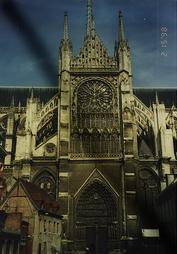 The Cathedral of Notre-Dame D'Amiens is the Gothic
cathedral located in the historic city of Amiens,
France, in the Somme River valley north of Paris. It
is the largest of the three great Gothic cathedrals
built in France during the 13th century, and it
remains the largest in France. The cathedral's
elaborately decorated exterior has its fullest
expression in the double-towered west facade, which
is dominated by three deep-set arched portals and a
richly carved gallery below the immense rose window.
Construction of the nave began in 1220 under the
direction of the architect Robert de Luzarches. The
nave and western facade were completed by 1236, and
most of the main construction was finished about
1270. Many later additions took place, including the
installation of the grand organ in 1549 and the
erection of a 367-foot spire during the same century.
The cathedral at Amiens was the site of several
noteworthy events, including the marriage of Charles
VI to Isabella of Bavaria in 1385. Despite heavy
fighting around Amiens during World Wars I and II,
the cathedral escaped serious damage.
The Cathedral of Notre-Dame D'Amiens is the Gothic
cathedral located in the historic city of Amiens,
France, in the Somme River valley north of Paris. It
is the largest of the three great Gothic cathedrals
built in France during the 13th century, and it
remains the largest in France. The cathedral's
elaborately decorated exterior has its fullest
expression in the double-towered west facade, which
is dominated by three deep-set arched portals and a
richly carved gallery below the immense rose window.
Construction of the nave began in 1220 under the
direction of the architect Robert de Luzarches. The
nave and western facade were completed by 1236, and
most of the main construction was finished about
1270. Many later additions took place, including the
installation of the grand organ in 1549 and the
erection of a 367-foot spire during the same century.
The cathedral at Amiens was the site of several
noteworthy events, including the marriage of Charles
VI to Isabella of Bavaria in 1385. Despite heavy
fighting around Amiens during World Wars I and II,
the cathedral escaped serious damage.

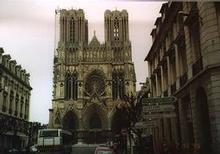 The Cathedral of Notre-Dame D'Reims
is located in the city of Reims, France, on the Vesle
River east-northeast of Paris. Reims was the site of
25 coronations of the kings of France, from Louis
VIII in 1223 to Charles X in 1825, including the
crowning of Charles VII in 1429 in the presence of
Joan of Arc. The cathedral, which was begun in 1211
was modeled on Chartres Cathedral and was intended to
replace an earlier church destroyed by fire in 1210.
The main construction was overseen by four different
architects and lasted some 80 years; expansions and
decorative work continued on the church for
centuries. Reims Cathedral incorporated several new
architectural techniques, notably bar tracery. The
twin towers in the west facade have a height of 266
feet. This unity is emphasized by the use of nearly
identical window types in the aisle and clerestory
stories, as well as the complementary rose windows.
Reims is richly decorated with elegant masonry
sculpture and exceptional stained-glass windows,
making it one of the artistic masterpieces of the
French High Gothic period.
The Cathedral of Notre-Dame D'Reims
is located in the city of Reims, France, on the Vesle
River east-northeast of Paris. Reims was the site of
25 coronations of the kings of France, from Louis
VIII in 1223 to Charles X in 1825, including the
crowning of Charles VII in 1429 in the presence of
Joan of Arc. The cathedral, which was begun in 1211
was modeled on Chartres Cathedral and was intended to
replace an earlier church destroyed by fire in 1210.
The main construction was overseen by four different
architects and lasted some 80 years; expansions and
decorative work continued on the church for
centuries. Reims Cathedral incorporated several new
architectural techniques, notably bar tracery. The
twin towers in the west facade have a height of 266
feet. This unity is emphasized by the use of nearly
identical window types in the aisle and clerestory
stories, as well as the complementary rose windows.
Reims is richly decorated with elegant masonry
sculpture and exceptional stained-glass windows,
making it one of the artistic masterpieces of the
French High Gothic period.

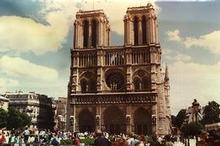 Notre-Dame de Paris cathedral church of Paris, France
is the most famous of the Gothic cathedrals of the
Middle Ages and is distinguished for its size,
antiquity, and architectural interest. Notre-Dame
lies at the eastern end of the Île de la Cité and was
built on the ruins of two earlier churches, which
were themselves predated by a Gallo-Roman temple
dedicated to Jupiter. The cathedral was initiated by
Maurice de Sully, bishop of Paris, who about 1160
conceived the idea of converting into a single
building, on a larger scale, the ruins of the two
earlier basilicas. The foundation stone was laid by
Pope Alexander III in 1163, and the high altar was
consecrated in 1189. The choir, the western facade,
and the nave were completed by 1250, and porches,
chapels, and other embellishments were added over the
next 100 years. Notre-Dame Cathedral suffered damage
and deterioration through the centuries, and after
the French Revolution it was rescued from possible
destruction by Napoleon, who crowned himself emperor
of the French in the cathedral in 1804. Notre-Dame
underwent major restorations by the French architect
E.-E. Viollet-le-Duc in the mid-19th century. The
cathedral is the setting for Victor Hugo's historical
novel Notre-Dame de Paris.
Notre-Dame de Paris cathedral church of Paris, France
is the most famous of the Gothic cathedrals of the
Middle Ages and is distinguished for its size,
antiquity, and architectural interest. Notre-Dame
lies at the eastern end of the Île de la Cité and was
built on the ruins of two earlier churches, which
were themselves predated by a Gallo-Roman temple
dedicated to Jupiter. The cathedral was initiated by
Maurice de Sully, bishop of Paris, who about 1160
conceived the idea of converting into a single
building, on a larger scale, the ruins of the two
earlier basilicas. The foundation stone was laid by
Pope Alexander III in 1163, and the high altar was
consecrated in 1189. The choir, the western facade,
and the nave were completed by 1250, and porches,
chapels, and other embellishments were added over the
next 100 years. Notre-Dame Cathedral suffered damage
and deterioration through the centuries, and after
the French Revolution it was rescued from possible
destruction by Napoleon, who crowned himself emperor
of the French in the cathedral in 1804. Notre-Dame
underwent major restorations by the French architect
E.-E. Viollet-le-Duc in the mid-19th century. The
cathedral is the setting for Victor Hugo's historical
novel Notre-Dame de Paris.
![]()
![]()
![]()
![]()
![]()
![]()
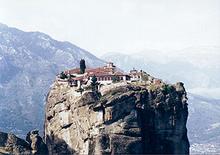 Monastery of the HOLY TRINITY (Agia Trias) in Kalambaka, Greece. Historical records tell us that this monastery was founded between 1458 and 1476 by one Donetios, who was probably the first ascetic to take up residence on the rock. The chapel of the monastery is cruciform with two pillars and a low cupola. The frescoes inside were painted in 1692 and were painted by the Monks Damaskinos, Arseios and Ionas. There are 140 steps to it now that have been hewn into the rock, but in the old days the only access was by rope ladder or a basket that was lifted to the top.
Monastery of the HOLY TRINITY (Agia Trias) in Kalambaka, Greece. Historical records tell us that this monastery was founded between 1458 and 1476 by one Donetios, who was probably the first ascetic to take up residence on the rock. The chapel of the monastery is cruciform with two pillars and a low cupola. The frescoes inside were painted in 1692 and were painted by the Monks Damaskinos, Arseios and Ionas. There are 140 steps to it now that have been hewn into the rock, but in the old days the only access was by rope ladder or a basket that was lifted to the top.
![]()
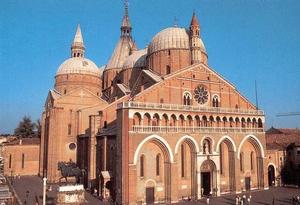 Saint Anthony's Basilica - Padua, Italy The Basilica of Saint Anthony, is the most important monument of the City of Padua. It is also one of the most important art treasures and one of Christianity's most popular shrines. Begun in 1232 by an unknown Franciscan Monk, it was finished towards the end of the century. The exterior Romanesque structure displays a strong influence of Saint Mark's Basilica in Venice, while the interior shows a high apse with nine radial chapels reflection the Gothic tradition. The Basilica is 115 meters long and a maximum of 55 meters wide, and the interior height is 38.5 meters. It is crowned by eight domes, two bell-towers and two miniature minaret towers.
Saint Anthony's Basilica - Padua, Italy The Basilica of Saint Anthony, is the most important monument of the City of Padua. It is also one of the most important art treasures and one of Christianity's most popular shrines. Begun in 1232 by an unknown Franciscan Monk, it was finished towards the end of the century. The exterior Romanesque structure displays a strong influence of Saint Mark's Basilica in Venice, while the interior shows a high apse with nine radial chapels reflection the Gothic tradition. The Basilica is 115 meters long and a maximum of 55 meters wide, and the interior height is 38.5 meters. It is crowned by eight domes, two bell-towers and two miniature minaret towers.
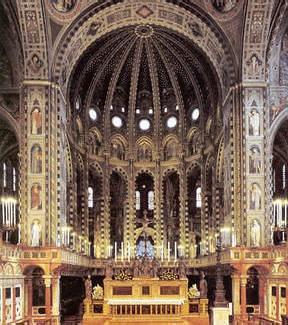 The Basilica of Saint Anthony, built in the form of a Latin Cross, is divided into three naves with a wide but short transept. The side aisles lead to the ambulacrum which surrounds the presbytery and the choir. The church, immersed in semi-darkness, is a harmonious blend of the imposing power of Romanesque architecture and the soaring Gothic style. Typical are the many funeral monuments in honor of military leaders, scholars, and clergymen. The most famous fresco is The Madonna and Child (1350) by Stefano Da Ferrara. There are 60 depictions of Our Lady in the Basilica. A large fresco of Saint Anthony Preaching from the Walnut Tree (1985) by Pietro Annigoni dominates the inside of the facade above the central door.
The Basilica of Saint Anthony, built in the form of a Latin Cross, is divided into three naves with a wide but short transept. The side aisles lead to the ambulacrum which surrounds the presbytery and the choir. The church, immersed in semi-darkness, is a harmonious blend of the imposing power of Romanesque architecture and the soaring Gothic style. Typical are the many funeral monuments in honor of military leaders, scholars, and clergymen. The most famous fresco is The Madonna and Child (1350) by Stefano Da Ferrara. There are 60 depictions of Our Lady in the Basilica. A large fresco of Saint Anthony Preaching from the Walnut Tree (1985) by Pietro Annigoni dominates the inside of the facade above the central door.

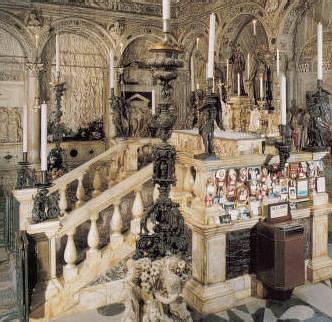



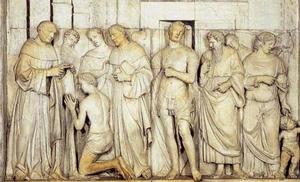

Home | Our Picture | Vacation Pics | Glock Page
Reiki/Hospice Care | Art Collection | Cathedrals
100 Modern Wonders
| Awards | Travel in Style
Glenergy's Sports Energy Center | Linda's Lenox
Family Ancestor Pictures | FoxTrot on FoxNews
Land of Enchantment | Contact us